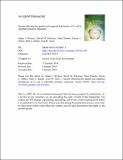Files in this item
Factors affecting the spatial and temporal distribution of E. coli in intertidal estuarine sediments
Item metadata
| dc.contributor.author | Wyness, Adam J. | |
| dc.contributor.author | Paterson, David M. | |
| dc.contributor.author | Mendo, Tania | |
| dc.contributor.author | Defew, Emma C. | |
| dc.contributor.author | Stutter, Marc I. | |
| dc.contributor.author | Avery, Lisa M. | |
| dc.date.accessioned | 2020-01-14T10:58:03Z | |
| dc.date.available | 2020-01-14T10:58:03Z | |
| dc.date.issued | 2019-04-15 | |
| dc.identifier | 257353793 | |
| dc.identifier | 025819bb-f083-4b77-91d7-ab5741217bbb | |
| dc.identifier | 85060101905 | |
| dc.identifier | 000458408200073 | |
| dc.identifier.citation | Wyness , A J , Paterson , D M , Mendo , T , Defew , E C , Stutter , M I & Avery , L M 2019 , ' Factors affecting the spatial and temporal distribution of E. coli in intertidal estuarine sediments ' , Science of the Total Environment , vol. 661 , pp. 155-167 . https://doi.org/10.1016/j.scitotenv.2019.01.061 | en |
| dc.identifier.issn | 0048-9697 | |
| dc.identifier.other | ORCID: /0000-0003-1174-6476/work/52888707 | |
| dc.identifier.other | ORCID: /0000-0003-4397-2064/work/148888389 | |
| dc.identifier.uri | https://hdl.handle.net/10023/19269 | |
| dc.description | Funding: University of St Andrews, The James Hutton Institute. DMP received funding from the Marine Alliance for Science and Technology for Scotland (MASTS), funded by the Scottish Funding Council (grant reference HR09011). | en |
| dc.description.abstract | Microbiological water quality monitoring of bathing waters does not account for faecal indicator organisms in sediments. Intertidal deposits are a significant reservoir of FIOs and this indicates there is a substantial risk to bathers through direct contact with the sediment, or through the resuspension of bacteria to the water column. Recent modelling efforts include sediment as a secondary source of contamination, however, little is known about the driving factors behind spatial and temporal variation in FIO abundance. E. coli abundance, in conjunction with a wide range of measured variables, was used to construct models to explain E. coli abundance in intertidal sediments in two Scottish estuaries. E. coli concentrations up to 6 log10 CFU 100 g dry wt-1 were observed, with optimal models accounting for E. coli variation up to an adjusted R2 of 0.66. Introducing more complex models resulted in overfitting of models, detrimentally effected the transferability of models between datasets. Salinity was the most important single variable, with season, pH, colloidal carbohydrates, organic content, bulk density and maximum air temperature also featuring in optimal models. Transfer of models, using only lower cost variables, between systems explained an average deviance of 42 %. This study demonstrates the potential for cost-effective sediment characteristic monitoring to contribute to FIO fate and transport modelling and consequently the risk assessment of bathing water safety. | |
| dc.format.extent | 4033513 | |
| dc.language.iso | eng | |
| dc.relation.ispartof | Science of the Total Environment | en |
| dc.subject | FIO | en |
| dc.subject | Estuaries | en |
| dc.subject | Pathogens | en |
| dc.subject | Bathing water quality | en |
| dc.subject | Sediments | en |
| dc.subject | GE Environmental Sciences | en |
| dc.subject | QH301 Biology | en |
| dc.subject | SH Aquaculture. Fisheries. Angling | en |
| dc.subject | NDAS | en |
| dc.subject.lcc | GE | en |
| dc.subject.lcc | QH301 | en |
| dc.subject.lcc | SH | en |
| dc.title | Factors affecting the spatial and temporal distribution of E. coli in intertidal estuarine sediments | en |
| dc.type | Journal article | en |
| dc.contributor.institution | University of St Andrews. School of Biology | en |
| dc.contributor.institution | University of St Andrews. Scottish Oceans Institute | en |
| dc.contributor.institution | University of St Andrews. Sediment Ecology Research Group | en |
| dc.contributor.institution | University of St Andrews. Marine Alliance for Science & Technology Scotland | en |
| dc.contributor.institution | University of St Andrews. St Andrews Sustainability Institute | en |
| dc.contributor.institution | University of St Andrews. Coastal Resources Management Group | en |
| dc.identifier.doi | 10.1016/j.scitotenv.2019.01.061 | |
| dc.description.status | Peer reviewed | en |
| dc.date.embargoedUntil | 2020-01-14 |
This item appears in the following Collection(s)
Items in the St Andrews Research Repository are protected by copyright, with all rights reserved, unless otherwise indicated.

